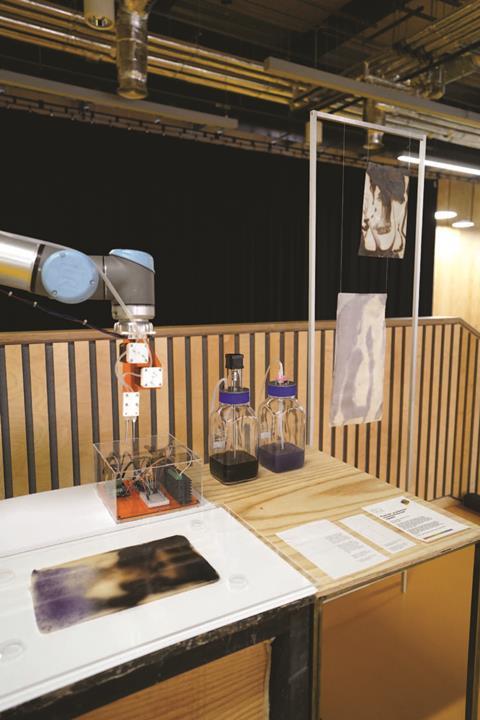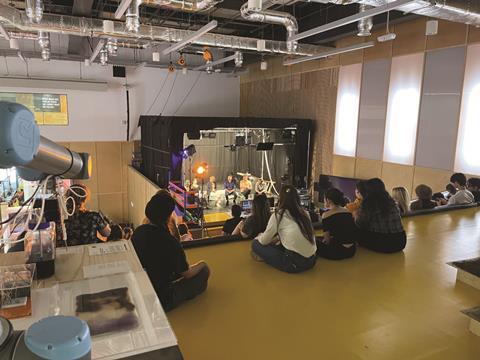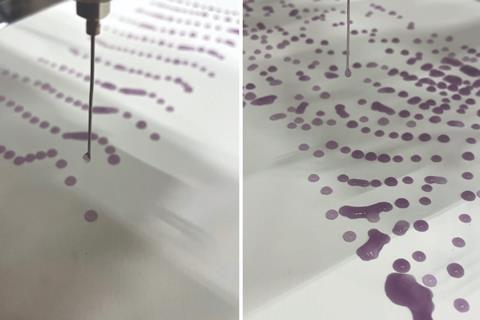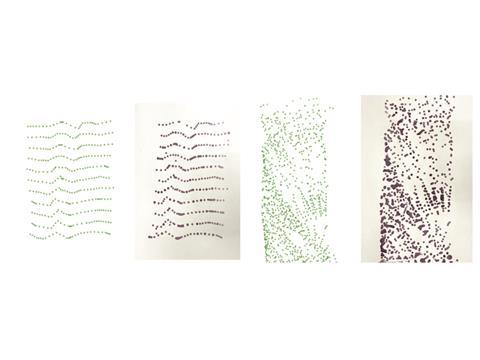Ella Hetherington, a PhD student in the Dept. of Biochemical Engineering and Bio-Integrated Design lab at UCL, reports on her Biochrome installation at the London Festival of Architecture, which was supported by an Outreach and Engagement Grant from Applied Microbiology International.
Biochrome was an installation aimed to demonstrate the application of microbial pigments in architecture and design. The installation was part of the Bartlett Transitions event for the London Festival of Architecture which saw over 360 advanced tickets booked and more walk-in visitors on the night.
The aim of the outreach was to connect with professionals and students in the architecture and arts industry to promote the use microorganisms within the built environment.

The event included other exhibits such as dance performances, digital art and architectural installations, drawing a crowd with a wide range of interests and backgrounds. The installation was at the centre of the exhibition space where table discussions and live performances were happening throughout the event.
Microbially produced pigments
The installation demonstrated the growth and large-scale application of microbially produced pigments. Two soil dwelling bacteria producing two pigments, Violacein and Melanin, were grown in a live display using ‘DIY bioreactors’ made from off the shelf parts.
Highlighted were the incredible natural functionalities of these pigments for the built environment such as pollutant absorption and remediation and energy harvesting, which surprised many visitors.

The installation attracted visitors with a wide range of expertise and from many sectors such as textile manufacturers, material scientists, architects, and artists. Each were able to offer unique perspectives on how microbially produced pigments might be applied in their industry.
Propositions included a sustainable alternative to energy- and water-intensive synthetic pigments for textile dyes and implementation as a bioactive anti-viral agent in passive air-filters for interiors.

Visitors enjoyed interacting with the material samples that were on display in the installation. Samples of material printed with the pigments such as paper, textiles and a seaweed-based biomaterial demonstrated how bacteria can produce objects of beauty that would even be desirable in architecture.
Popular bioreactors
Two styles of reactor were built for the installation, a bubble column and stirred tank. The bioreactors were particularly popular, provoking many of the most interesting discussions with visitors throughout the evening about what is necessary to grow microorganisms and how to optimise performance.
Visitors offered fascinating suggestions on how to approach challenges from their own experience such as how to optimise oxygen transfer, maintain sterility and monitor growth using the integrated sensors. Some of the suggestions from members of the public such as creating a mesh column in the centre to direct bubble flow were integrated into the next iteration of bioreactor.

The bioreactors were designed to use off-the-shelf or easily reproducible parts through 3D printing or laser cutting. Using widely available tools and Arduino programming also demonstrated how accessible growing microorganisms can be, with many students commenting that they were interested in testing the bioreactors later with other organisms such as algae.
After the exhibition, the bioreactors will be for open use for students in the architecture school. The blueprint and Arduino code for the reactors will also be made available on GitHub as an open-source resource.
Dropping slow
A robotic arm with a dropper mechanism demonstrated how to automate the patterning of the pigment produced in the bioreactors over a large surface, reimaging the application of bacteria beyond a petri dish scale.

Samples of the pigment grown during the event were used to create large-scale prints through computer programmed drawings. Not only was this element of the display engaging for visitors at the event, but the development of the tools to facilitate this required input from designer makers offering a unique opportunity for interdisciplinary collaboration.
The dropper was designed especially for the installation and 3D printed in the workshop, and the tool produced will continue to be used by students at the university.

Glasshouse legacy
Following the London Festival of Architecture event, an iteration of the DIY bioreactor was assembled at St Andrews Botanic Garden for a pilot study taking over one of the glasshouses to display the bioreactor and test growing over several days. Here staff at the garden were able to interact with the reactor and watch the growth.
This pilot run will precede a workshop at the end of summer where larger panels that have been patterned with the grown microbial pigments will be on display in the Bioscope pavilion, a temporary exhibition space.

The garden is one of the top places to visit in St Andrews and sees a wide variety of visitors from local residents to tourists from all around the world. The garden also hosts a summer school for children and offers activities for school groups all through the year.
Many thanks to Applied Microbiology International for their support in this project. This grant has enabled the production of many resources that will promote the application of microbiology in architecture for use in the architecture school and beyond. This project has also sparked many interesting conversations and new connections with people from other sectors facilitating and enriching interdisciplinary research and thinking that will be ongoing.
To find out more about AMI’s grants and awards, click HERE.
Supporting documents
Click link to download and view these filesImage Pectobacterium artrosepticum
Image, FileSizeText 0.52 mb
Topics
- Applied Microbiology International
- Bartlett Transitions
- Be inspired
- Biochrome
- Bioscope
- Climate Action
- Community
- Early Career Research
- Ella Hetherington
- Future Technologies
- Industrial Microbiology
- London Festival of Architecture
- melanin
- Microbial Biotechnology
- Soil & Plant Science
- St Andrews Botanic Garden
- UCL
- Violacein







No comments yet